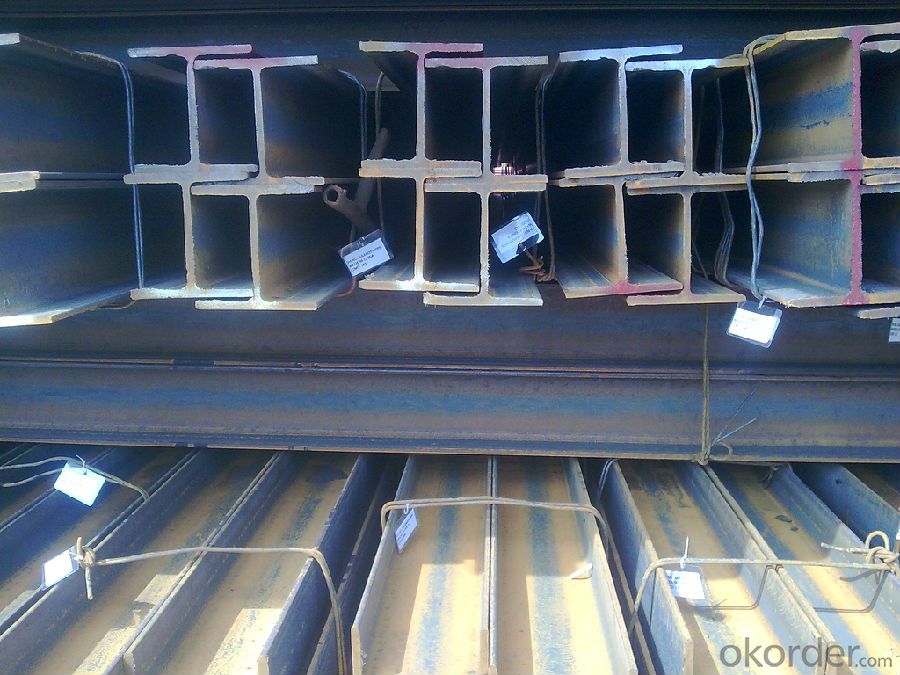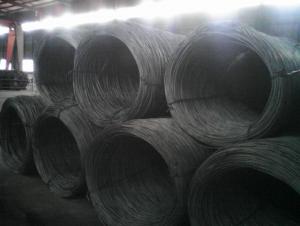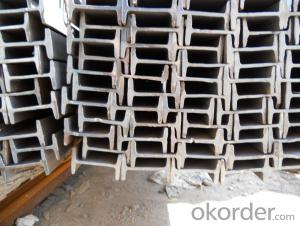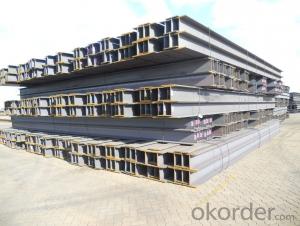Structural Steel Hot Rolled H-Beam High Quality
- Loading Port:
- China Main Port
- Payment Terms:
- TT or LC
- Min Order Qty:
- -
- Supply Capability:
- -
OKorder Service Pledge
OKorder Financial Service
You Might Also Like
Product Description:
OKorder is offering high quality Hot Rolled Steel I-Beams at great prices with worldwide shipping. Our supplier is a world-class manufacturer of steel, with our products utilized the world over. OKorder annually supplies products to European, North American and Asian markets. We provide quotations within 24 hours of receiving an inquiry and guarantee competitive prices.
Product Applications:
Hot Rolled Steel I-Beams are ideal for structural applications and are widely used in the construction of buildings and bridges, and the manufacturing, petrochemical, and transportation industries.
Product Advantages:
OKorder's Steel I-Beams are durable, strong, and resist corrosion.
Main Product Features:
· Premium quality
· Prompt delivery & seaworthy packing (30 days after receiving deposit)
· Corrosion resistance
· Can be recycled and reused
· Mill test certification
· Professional Service
· Competitive pricing
Product Specifications:
Manufacture: Hot rolled
Grade: Q195 – 235
Certificates: ISO, SGS, BV, CIQ
Length: 6m – 12m, as per customer request
Packaging: Export packing, nude packing, bundled
SIZE(mm) | DIMENSION(kg/m) |
100*100 | 16.9 |
125*125 | 23.6 |
150*75 | 14 |
150*150 | 31.1 |
148*100 | 20.7 |
198*99 | 17.8 |
200*100 | 20.9 |
248*124 | 25.1 |
250*125 | 29 |
Payment:
-Invoicing on theoretical weight or actual weight as customer’s request.
-FOB, CFR or CIF.
-Regular terms of payment:
1, 30% payment in advance, the remaining balance (70% payment) against the copy of B/L.
2, 30% payment in advance, the remaining balance (70% L/C) against the copy of B/L.
3, Negotiable.
-The payment terms will be written in contraction detailed.
FAQ:
Q1: Why buy Materials & Equipment from OKorder.com?
A1: All products offered byOKorder.com are carefully selected from China's most reliable manufacturing enterprises. Through its ISO certifications, OKorder.com adheres to the highest standards and a commitment to supply chain safety and customer satisfaction.
Q2: How do we guarantee the quality of our products?
A2: We have established an advanced quality management system which conducts strict quality tests at every step, from raw materials to the final product. At the same time, we provide extensive follow-up service assurances as required.
Q3: How soon can we receive the product after purchase?
A3: Within three days of placing an order, we will begin production. The specific shipping date is dependent upon international and government factors, but is typically 7 to 10 workdays.
Images:


- Q: Are steel H-beams suitable for use in high-rise buildings?
- Yes, steel H-beams are suitable for use in high-rise buildings. They provide excellent structural support, allowing for the construction of tall and sturdy buildings. The H-shape design of these beams offers superior strength and load-bearing capacity, making them an ideal choice for handling the vertical and horizontal forces experienced in high-rise structures.
- Q: What are the considerations when designing connections for Steel H-Beams?
- When it comes to designing connections for Steel H-Beams, there are several crucial factors to bear in mind. The primary concern is to guarantee the structural integrity and safety of the connection. This entails conducting calculations to determine the loads and forces that the connection will endure, such as gravity loads, lateral loads, and wind loads. These calculations will help ascertain the appropriate size and type of connection needed to withstand these forces. Another factor to consider is the specific H-beam being utilized and its unique properties. Different H-beams will have varying dimensions, strengths, and load capacities, so it is essential to select a connection that is compatible with the particular H-beam being used. Additionally, the connection must be designed to accommodate any potential movement or deflection of the H-beam, such as thermal expansion or contraction. The choice of connection method is also a significant consideration. There are various options available, including welding, bolting, or a combination of both. Each method has its own advantages and limitations, such as cost, ease of installation, and the ability to withstand different types of loads. The selection of the connection method will depend on factors such as the project requirements, available resources, and specific design considerations. Furthermore, the location and environment in which the connection will be installed should be taken into account. Factors such as exposure to corrosive substances, extreme temperatures, or high humidity can impact the durability and longevity of the connection. In such cases, appropriate protective measures, such as coatings or galvanization, may be necessary to prevent corrosion and ensure the connection's longevity. Lastly, it is crucial to consider any applicable codes, standards, and regulations when designing connections for Steel H-Beams. These codes and standards provide guidelines and requirements for the design, fabrication, and installation of structural connections, ensuring they meet safety and performance criteria. Compliance with these codes and standards is vital to ensure the connection functions as intended and meets the necessary safety standards. In conclusion, the design of connections for Steel H-Beams necessitates careful consideration of the loads and forces involved, the properties of the H-beam, the method of connection, the installation environment, and compliance with applicable codes and standards. By taking these considerations into account, a safe, efficient, and durable connection can be designed for Steel H-Beams.
- Q: Can Steel H-Beams be used in both indoor and outdoor construction projects?
- Yes, Steel H-Beams can be used in both indoor and outdoor construction projects. They are commonly used in various applications such as residential, commercial, and industrial construction projects, both indoors and outdoors. Steel H-Beams provide structural support and stability, making them suitable for a wide range of construction projects regardless of the environment.
- Q: Can Steel H-Beams be painted or coated for aesthetic purposes?
- Steel H-beams can indeed be painted or coated to improve their aesthetics. By applying paint or a protective coating, the appearance of the steel H-beams can be enhanced while also safeguarding them against corrosion. Typically, this involves a procedure that includes cleaning and preparing the surface of the H-beams, applying a primer or base coat, and then applying the desired paint or coating. To meet specific aesthetic preferences, various finishes, colors, and textures can be selected. Furthermore, the paint or coating serves as an extra barrier against rust and other environmental elements, effectively extending the lifespan of the H-beams.
- Q: How do steel H-beams compare to timber beams?
- Steel H-beams are generally stronger, more durable, and have a higher load-bearing capacity compared to timber beams. Additionally, steel beams are fire-resistant and less susceptible to rot, pests, and warping, making them a preferred choice for heavy construction and structural applications. However, timber beams are often more cost-effective, easier to work with, and can provide a more aesthetic appeal in certain architectural designs. Ultimately, the choice between steel H-beams and timber beams depends on the specific needs, budget, and design preferences of the project.
- Q: Are steel H-beams suitable for oil refineries?
- Yes, steel H-beams are suitable for oil refineries. They provide structural strength and stability, making them ideal for supporting heavy loads and withstanding the harsh conditions typically found in oil refinery facilities. Additionally, steel H-beams are versatile and can be easily customized and fabricated to meet specific project requirements in oil refineries.
- Q: What's the difference between hot rolled H steel and welded H? Is it the same weight?
- Select various grades of steel. Hot rolled H steel is mainly Q235B and Q345B, which requires small batch of special steel, the production plant can not be produced. Welding can be made according to the requirements of the steel plate.
- Q: How do Steel H-Beams compare to other structural beams, such as I-beams or wood beams?
- Construction widely utilizes Steel H-beams, also known as wide flange beams, due to their numerous advantages over other structural beams like I-beams or wood beams. To begin with, steel H-beams possess a higher strength-to-weight ratio in comparison to wood beams. This implies that they can support larger loads while being lighter, making them ideal for heavy-duty construction projects. On the contrary, wood beams have limited load-bearing capacity and may necessitate larger dimensions to achieve similar strength. Another benefit of steel H-beams is their design flexibility and versatility. These beams can be easily customized in terms of length, size, and shape, making them suitable for a wide range of construction applications. Additionally, steel H-beams can be joined together using welding or bolting techniques, allowing for the construction of intricate and stable structures. In terms of durability and resistance, steel H-beams outperform wood beams. They are immune to rot, decay, or insect damage, unlike wood, making them a more long-lasting option. Furthermore, steel H-beams are fire-resistant, making them a safer choice for construction in high-risk areas. Moreover, steel H-beams offer superior stability and structural integrity compared to I-beams. The design of H-beams, with their wider flanges and thinner web, facilitates better load distribution and reduces the risk of bending or buckling under heavy loads. This structural stability is particularly crucial in large-scale construction projects that necessitate dependable and strong support systems. Lastly, steel H-beams are more environmentally friendly than wood beams. Wood beams require the cutting down of trees, contributing to deforestation, whereas steel beams can be manufactured from recycled materials and are fully recyclable at the end of their life cycle. In conclusion, steel H-beams possess several advantages over other structural beams like I-beams or wood beams. They offer a higher strength-to-weight ratio, better durability, versatility in design, and superior stability. These factors make steel H-beams a preferred choice in many construction projects, particularly those requiring heavy loads and long-lasting structures.
- Q: What's the difference between welded H - section steel and high frequency welded H - section steel and hot rolled H section steel?
- Specification and material. When the hot-rolled H steel can fully replace welding of H steel, and the former than the latter to ensure quality. In general, in the structural design of high-rise buildings, should adopt the hot-rolled H steel, steel portal frame of light steel plant, selection of welding H steel with variable cross-section steel index is better, but the project cost can not save much, the reason is that the processing capacity of hot-rolled H steel is smaller, shorter duration, if the calculation of the comprehensive economic benefits (including the project put into use), play a decisive role in the period under the condition of optional hot-rolled H steel, but when the time limit for not strict or some image project, is in line with the principle of conservation of resources selection of welding H steel.
- Q: Are steel H-beams suitable for power plants?
- Steel H-beams are commonly used in power plants because of their strength and durability. These structures need to be strong enough to support heavy equipment and withstand extreme conditions. Steel H-beams are known for their ability to bear heavy loads and resist bending, making them a popular choice for power plant construction. H-beams are specifically designed to evenly distribute weight, making them ideal for supporting heavy machinery like generators, boilers, and turbines. Their shape, with a wider flange and thinner web, provides stability and structural integrity, which is necessary for withstanding the dynamic loads and vibrations commonly found in power plant operations. Moreover, steel H-beams can be customized to meet specific design requirements and can be easily assembled, allowing for quick and efficient construction. This is crucial in power plants where strict deadlines and prompt operation are necessary. Furthermore, steel H-beams have excellent corrosion resistance, which is essential in the power plant environment where exposure to moisture, chemicals, and high temperatures is common. This ensures the longevity and reliability of the structural components. In conclusion, steel H-beams are suitable for power plants due to their strength, load-bearing capacity, stability, and resistance to corrosion. Their ability to support heavy equipment, withstand extreme conditions, and provide efficient construction makes them a preferred choice for power plant construction projects.
Send your message to us
Structural Steel Hot Rolled H-Beam High Quality
- Loading Port:
- China Main Port
- Payment Terms:
- TT or LC
- Min Order Qty:
- -
- Supply Capability:
- -
OKorder Service Pledge
OKorder Financial Service
Similar products
Hot products
Hot Searches
Related keywords




























